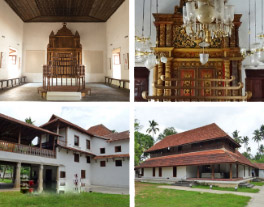The Story of Conservation

The conservation of historic buildings, their preservation along with development, and informal dissemination of information are the prime concerns of the Muziris Heritage Project. The monuments and sites in the Muziris region are physical reminders of history, and indicators of the diversity of cultures and traditions that the ancient port city once enjoyed. The Muziris Heritage Project is thus the story of tangible and intangible elements that created this ancient hub of world sea trade.
The uniqueness of the Muziris project is that it is designed in such a way as to involve and integrate the local community in all its intended initiatives. Through appropriate activities contributing to the social and economic development of the region as well as ensuring an enhanced quality of life, the project maintains a balance between development and conservation.
Muziris Heritage Project
The Muziris Heritage Project is one of the biggest conservation projects in India, where the state and the central governments have come together, with support from the UNESCO, to conserve a rich culture that is 3000 years old or more. Since 2016, 19 departments of the state government have been working together on the project, collaborating with various national and international agencies, and ensuring proper documentation and research in all areas.
The region that forms a part of the heritage project lies between North Paravur in Ernakulam district and Kodungallur in Thrissur district and stretches across twelve panchayats and two municipalities.
The shrines, forts, palaces, seminaries, cemeteries, boatyards and markets, spread over the whole area that have deep connections with the history of the state, will be preserved and conserved. Further, by showcasing the traditional crafts patronized during that time and the markets that were in existence, the exhibits in the heritage museums will throw considerable light on the life of the people, and thereby illustrate a significant era in the history of Kerala. Various performing arts, that represent the non-physical aspect of the land’s history and the culture of the Muziris region, are also under the process of conservation.
As part of the initial phase of the project, eight museums have been opened to the public. The already functional museums in Muziris are examples of restoration work that has been able to retain their heritage significance. In its initial phase, the list of buildings to be restored included a diverse mix of heritage sites. But that was a daunting task because numerous challenges and threats – from delayed maintenance to damage wrought by natural causes – slowed down the momentum of the project.
Recognizing the need to safeguard the natural environment for the benefit of present and future generations, the project has thereafter succeeded in operating within the tourism sector, while fully embracing the principles of heritage conservation. Preserved through conservation processes, they have become viable platforms capable of achieving the targeted goals of sustainable development and inter-cultural dialogues. While the reconstruction of this old port city gives us precious peeks into its long-forgotten history and culture, it also inspires us to revere its past glory, observable in both tangible and intangible forms.
Two archaeological sites, Pattanam and Kottappuram, where archaeological excavations and explorations are being undertaken, are the keys that open to the hoary past, and unlock the many mysteries that have intrigued archaeologists and historians alike. Many artefacts of interest have been unearthed that throw light on the historical times and cultural mores of the legendary port of Muziris.
Today, the recreated Muziris is a place that disseminates information about a long-forgotten past, and initiates various non-formal educational activities for students of all age groups. This is the only place that offers a live and continuous learning platform for an understanding of a segment of Kerala history, as Pattanam excavations continue to unearth valuable vestiges of the past that offer glimpses of the lives of our ancestors.
Excavations So Far
Muziris holds the unique distinction of having yielded a complete human skeleton for the first time in India, from the Kottappuram Fort area. Some of the other items excavated from here include Chinese coins, Chinese inscriptions, pieces of decorated porcelain, West Arabian pottery pieces, iron nails, bullets, stone beads, 17th century Dutch coins and tiles, all of which will be set up in the museums.
Pattanam Excavation
The significance of Pattanam, a town close to Kodungallur and North Paravur in Kerala, cannot ever be overstated. Excavations in the area, undertaken by the Kerala Council for Historical Research (KCHR), have unearthed certain remains of a lost culture, and archaeologists are positive that they constitute incontrovertible evidence of a long dysfunctional port. Valuable pieces of amphoras [ancient Greek jars or vases with large oval bodies, narrow cylindrical necks and two large handles that rise up to their mouths], semi-precious stones like carnelian, beryl and stones that are blue, green and red in colour are indicators of a trading culture of those times.
Pattanam also is the site from where a small boat, five to six metres long, was recovered from four metres below ground level. Burial sites which carry remains of cremated bodies, like pieces of bone, and objects of daily use have also been found here. The large number of Roman artefacts – particularly small gold coins from a place named Valluvally – unearthed from the site serve as evidence of the extensive maritime contacts that this region had with Rome during the early historic period.
Kottappuram Excavation
The excavation carried out in the Kottappuram area has unearthed a Portuguese fort and numerous other remnants of past cultures. The Kottappuram Fort, also known as Kodungallur Fort, was built in 1523. Chinese wares, red slip ware, other pottery artefacts and iron objects are also included in the list of Kottappuram findings.

